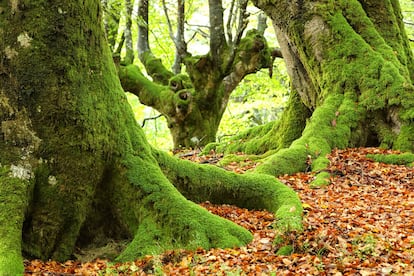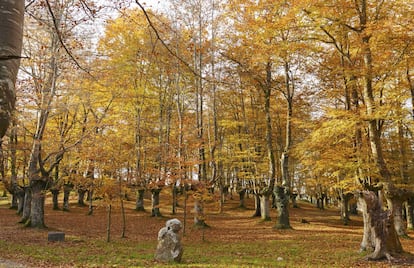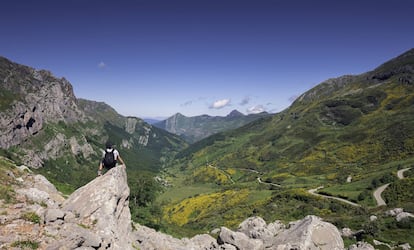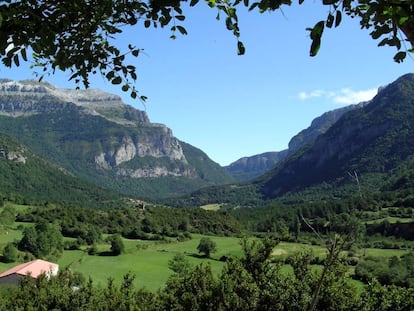Reconnecting with nature: five trails for forest immersion in Spain
A new book provides suggestions for enjoying ‘shinrin-yoku,’ a popular Japanese concept involving mindful walks to reduce stress levels and improve general wellbeing

“This is not about tree hugging or walking barefoot through the leaves,” says Alex Gesse, the co-author along with Gorka Altuna of Forest bathing. 50 Routes to Feel Nature. Instead, what Gesse is advocating are walks in nature to improve mental health and general wellbeing while steering clear of any mystical undercurrents.
“A forest bath is nothing more than a contemplative experience that connects us to the natural environment through our emotions and the five senses,” says Gesse, who is one of Europe’s most eminent experts in shinrin-yoku, which literally means “absorbing the atmosphere of the forest” in Japanese.
Shinrin-yoku is a technique that Japan successfully incorporated into its public healthcare system in the 1980s to reduce the population’s high stress levels, taking advantage of the fact that three-quarters of its territory is covered by trees. “In a world where everything goes too fast, forest baths involve walking slowly, feeling the path, touching the trees, the water, hearing the birds sing, the wind howl, the dew drops fall,” explains Gesse in the foreword.
It doesn’t necessarily have to be in a forest; a city park next to your house will also do, or any green area that you particularly connect withAlex Gesse, forest immersion expert
Having grown up playing in the Mediterranean forests of the Empordà in Catalonia, Gesse has worked on issues related to nature and health for many years, but it was in 2016 that he founded the Instituto Baños de Bosque (or Forest Baths Institute) and three years later, together with Irish ecologist Shirley Gleeson, he created the Forest Therapy Institute, with the aim of ultimately incorporating these walks into Spain’s public healthcare system.
Gesse believes that despite the fact that a growing number of city councils in Spain are including this type of initiative among their public services, Spanish doctors are still some way off giving patients what he terms “the green prescription,” something which “is already a trend in other countries around us, such as Scotland and more recently Germany, where the doctor can prescribe, in addition to medication, a therapy in the forest as a practical complement to treatment.”
Based on his own experience of organizing hundreds of therapeutic walks and using what he learned from the teachings of Chinese immunologist Qing Li, the world’s foremost authority on forest medicine and father of the shinrin-yoku movement, Gesse believes that getting lost in nature strengthens the immune system, reduces stress and lowers blood pressure and heart rate. And he points out an important fact: “It doesn’t necessarily have to be in a forest; a city park next to your house will also do, or any green area that you particularly connect with.”
“Forests already act as health infrastructures via the ecosystem services they provide such as filtering rain, purifying the air, absorbing carbon dioxide and releasing oxygen,” adds his colleague Gorka Altuna. And it seems to be true that forest therapies aimed at certain disadvantaged groups have an almost immediate positive effect. “One of my first projects was with children at risk of social exclusion,” says Gesse. “At the end of the walks one of them told me, ‘The forest calms my bad thoughts.’”
Equally positive results were obtained when forays into nature were organized for schizophrenia patients and victims of violence against women.
Short walks on remote trails
It might seem obvious that a walk in the countryside needs no particular preparation, but many people require a helping hand to reconnect with nature in a “natural” way. The aim of a forest immersion is not to do physical exercise, and Gesse recommends that first-timers be accompanied by a qualified professional. He himself has instructed around 200 environmental educators who perform forest immersion and therapies in natural parks and green spaces in both Europe and the Americas. The task of these instructors is, above all, “to create a favorable environment in which the participants feel safe and comfortable, both physically and psychologically.”
Forest bathing usually lasts less than two hours, takes place on little frequented trails, and is divided into three phases. The first leg of the journey is meant to “awaken the senses and get in harmony with the rhythms of nature.” The second involves multiple activities, from feeling the texture of a flower to sitting in silence to listen to the sound of the earth.
Forests already act as health infrastructures via the ecosystem services they provide such as filtering rain, purifying the air, absorbing carbon dioxide and releasing oxygenGorka Altuna, forest immersion expert
The activities in the second leg vary according to the participants. As Gesse points out, “It is not the same to go for a walk with managers of multinationals who seek to strengthen creativity and communication as it is to go with a group of 80-year-old grandparents.”
The last phase of the therapy includes a feedback session during which it is common to hear remarks such as “I have lost track of time,” or “I felt like a kid,” or “I am more relaxed than ever.” Ultimately, the aim is to be aware of having experienced something different before returning to the city. “There is no right or wrong way to communicate with the forest,” says Gesse. “Each person connects differently. You just have to let yourself go.”
Many of the routes described in the book are frequented by hikers, but unlike a hike, “the important thing is not to arrive at a destination, but to enjoy the experience of living with the forest and its inhabitants, whatever their shape and size.”
Gesse has chosen five of these 50 routes for EL PAIS’ travel section El Viajero. Each of them comes with information on organic compounds called monoterpenes that protect trees from predators and parasites as well as the ionization levels in the air on each stretch of the route. Scientific studies suggest that both these natural elements could have a direct beneficial effect on people’s immune systems.
1. Guenzelai trail in Urkiola natural park (Basque Country)

The natural park of Urkiola lies between the Basque provinces of Biscay and Álava and is home to an enormous range of fauna and flora. Covering an area of 5,958 hectares, the park encompasses three mountain ranges – the Aramotz-Eskubaratz, the Duranguesado and the Arangio. “Coming to Urkiola to enjoy a forest immersion means walking through the diverse landscapes that hide this spectacle of nature – green pastures, leafy and colorful forests and steep limestone peaks that shelter the valleys with their protective mantle,” says Johanna Maluenda, the creator of this route.
The trail takes visitors through the Astxiki beech forest and the Guenzelai forest, which is home to ancient beech trees. Also in evidence are pine and birch trees, the latter giving Urkiola its name in Basque – the “land of birches.”
The route is little more than a kilometer long but it offers participants the chance to enhance their sense of touch, “laying our hands on the greyish trunks of the beech trees and moving our fingers to experience their dampness and roughness.” There is also the opportunity to become aware of the firm but soft soil and “the cottony roots of the beech trees” under foot. The tour ends in the Guenzelai pastures “where you will feel the urge to sit on the soft and velvety grass that colors the entire place an intense green.”
2. Lagunas Glaciares de Neila natural park (Burgos)

The Collado de Neila trail, which is a kilometer and a half long but reasonably easy, is located in the Lagunas Glaciares de Neila natural park, in the Demanda mountain range in Burgos province. The trail follows two streams and takes visitors into forests of wild pine mixed with beech, birch and holly trees. The creator of this route, Noemí Hortigüela, talks about pastures that are alive with the sound of cow bells. Along with horses, the cows graze in the same meadows that once welcomed shepherds returning from pastures further south in Extremadura at the start of each summer.
According to Hortigüela, a spring excursion means enjoying the velvety texture and the aroma of wild rose petals while strolling among poplars, willows and ash trees. When the first beech trees appear, “we will be able to enjoy contemplating the komorebi, a Japanese word that means ‘the light of the sun filtering through the leaves of the trees.’ While many trees offer this possibility, the superimposed branches of the beech tree give it a special warmth.”
3. Braña la Campa. Somiedo natural park (Asturias)

Of the four great valleys that lie within Somiedo natural park, in Spain’s small northern Asturias region, the therapist Raquel de la Insúa chose Saliencia as the setting for her forest immersion among oaks, ashes, maples and lime trees. Besides being the wildest of the four valleys, Saliencia also has the largest number of teitos – traditional stone constructions with roofs made from broom branches, which were used to shelter people and livestock in days gone by and which now give the area the air of a medieval village.
An instructor from the Forest Baths Institute, Insúa describes a simple 1.5-kilometer journey in which she was able to immerse herself in the beauty of this landscape. Humid and green all year round, the soft fresh breeze is ever present, caressing the face of the walker, whose view of the sky is obscured by the budding branches of beech trees in spring that turn red and gold in the fall, in Insúa’s own description.
4. Retamar Bridge over the River Guadarrama (Madrid)

“Along its entire length, the Guadarrama River creates a natural riverside environment that, despite intense human activity, still has areas of great ecological value where you can find places to lose yourself and enjoy a unique environment,” says Paco García, an expert in forest immersion.
Taking as a starting point the recreational area of the Retamar Bridge in the municipality of Las Rozas, northwest of the Spanish capital, García recommends a flat, circular route two kilometers long which brings visitors to a riverside forest in the process of recovery. The forest itself allows one to “admire how nature opens up a path across the scars of human activity in the area.” A grove of poplars and ash trees serves as a natural corridor for the fauna as well as for walkers. The route also passes through an area of herbs, “an ideal place to smell and explore not only the textures with our hands, but also the smells and how they impregnate our fingers.”
Built during the reign of Philip II in the 16th century, the Retamar Bridge itself allows us to experience “the sensations generated by the temperature of the granite on our skin.” The sound of the River Guadarrama, “audible if the walker pays attention” provides a relaxing background sound while “its transparency most of the year and shallowness will perhaps allow us to see some fish and, with luck, some water birds,” says García.
5. Les Estunes, Lake Banyoles natural space (Girona)

The forest of Les Estunes is very close to Lake Banyoles, the largest natural pond in Catalonia. Marta Ayats, the monitor in charge of this 850-meter-long route, recommends doing it on weekdays to avoid the crowds.
The immersion for our senses starts with the view of a powerful oak tree, which acts as a gateway to a magical domain that has inspired legends about mythical creatures such as the goges, “the peculiar water nymphs that spent the night spinning near the lake to then take refuge in the large cracks in the travertine rock formed in previous geological eras and on top of which abundant vegetation and a forest of oaks has grown,” explains Ayats.
Travertine is highly valued by sculptors and craftsmen and is formed by layers of lime deposited by the groundwater of the rivers Llierca and Borró. “Calmly, step by step, we breathe, stop from time to time and focus on the breeze that moves the leaves in the branches, the ivy that climbs to envelop trees 15 to 20 meters high, and the moss and ferns that share this humid habitat,” writes Ayats. “This space, as small as it is majestic, reflects how nature disinterestedly offers up its richness and diversity for our senses to enjoy and to make us feel part of it.”
English version by Heather Galloway.
Tu suscripción se está usando en otro dispositivo
¿Quieres añadir otro usuario a tu suscripción?
Si continúas leyendo en este dispositivo, no se podrá leer en el otro.
FlechaTu suscripción se está usando en otro dispositivo y solo puedes acceder a EL PAÍS desde un dispositivo a la vez.
Si quieres compartir tu cuenta, cambia tu suscripción a la modalidad Premium, así podrás añadir otro usuario. Cada uno accederá con su propia cuenta de email, lo que os permitirá personalizar vuestra experiencia en EL PAÍS.
En el caso de no saber quién está usando tu cuenta, te recomendamos cambiar tu contraseña aquí.
Si decides continuar compartiendo tu cuenta, este mensaje se mostrará en tu dispositivo y en el de la otra persona que está usando tu cuenta de forma indefinida, afectando a tu experiencia de lectura. Puedes consultar aquí los términos y condiciones de la suscripción digital.











































